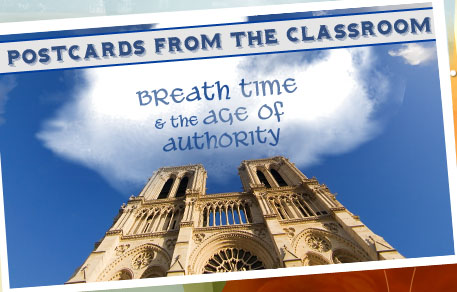Breath Time and the Age of Authority

When Kitty Brazelton modestly says that she is “not the person you would expect to teach music history,” she’s referring to the fact that she is most often known as a rock musician.
Don’t be fooled, though. To look only at the rock-and-roll credentials is to bypass two very important facts. One: Brazelton is a composer first and foremost. And two: She knows her way around medieval music, and has been mining its richness and beauty since she first encountered it as an undergraduate in the early seventies. While still a student, she began combining it with jazz, rock, and “surrealist 12-tone music” in her composition, and she has never left it behind. For living proof, refer to Hildegurls, the “21st-century medieval quartet” Brazelton co-founded, which revives the music of medieval abbess Hildegard von Bingen with electronic elements alongside mellifluous singing.
“Medieval music is familiar and strange at the same time; it’s so foreign, and yet it’s so much part of our genetic makeup.”
In her course Breath Time and the Age of Authority–yes, that’s “breath time,” a phrase unto itself–Brazelton is challenging her students to listen to plainchant and other medieval music on its own terms, to understand how it developed and how it shaped the centuries of music that came after it. And the music does pose a challenge: “It’s familiar and strange at the same time; it’s so foreign, and yet it’s so much part of our genetic makeup,” Brazelton says. But by looking at two elements in its development–one, breath time, and two, the “age of authority”–Brazelton gives her students a foothold into understanding why this music came about and how to listen to it.
“Breath time is about the way a plainchant was constructed–within the timing of one breath.”
“Breath time,” she says, “is about the way a plainchant was constructed–within the timing of one breath. Instead of being based on a beat that keeps on going on no matter what–like a heartbeat–it’s vocally centered, so the music stops whenever you take an in-breath. It’s a much more elastic way to think about the division of time, a completely different way. I’m interested in getting students to really question the way they think about time.
“Then there’s the ‘age of authority’, which is, in a way, about melody. When Charlemagne became Holy Roman Emperor in the ninth century, one of the conditions from Rome was that he standardize the practice of chant throughout the Empire. In order to accomplish that, they sent musical enforcers out to all the communities and began to notate what had been an oral tradition, to document these chant melodies. And one of the ways they tried to superimpose this Roman chant throughout France and all the rest of Europe was to invent a mythology that in the sixth century, Pope Gregory had received this body of Roman chant directly from God. You had to sing these particular melodies or you were a heretic. These melodies became like holy artifacts.
“What’s incredible is that you can’t stop the impulse to innovate, invent and be original. It’s ongoing. And people find ways to revere the fixed melody but then to build new melodies on top. So we develop a kind of vocal polyphony with simultaneous melodies– because you have to keep this original part, this piece of God, but you want to make new melodies. And over the centuries, this leads to the tonal system of harmony, which is an incredibly powerful system of expression.”
“You can’t stop the impulse to innovate, invent and be original. It’s ongoing. And people find ways to revere the fixed melody but then to build new melodies on top.”
Throughout the course, Brazelton has engaged her students in listening to a wide range of recordings and studying primary documents from the time, including writings from the fierce debates that arose over the centuries. “In the fourteenth century, there was an intense argument over a new style, the ars nova–some people thought the style was just a terrible tragedy, so there was a really vituperative exchange of published treatises.”
Brazelton has also taken her students deeper into the music by challenging them to compose it themselves. She often puts the same kind of constraints on them that medieval composers would have faced: using an existing melody–a medieval kyrie, for example–as a cantus firmus, and composing new melodies on top of it.
“I approach this stuff as a composer, and I’m driven by making music itself,” Brazelton says. “To bring it alive, we try to really dig into what it felt like to be there. We don’t know a lot about what happened in these early centuries–and yet because you have the same body, the same breath, the same heart, there are some things you might be able to figure out.”
 Kitty Brazelton has performed at the legendary New York punk rock club CBGB’s more than a hundred times; she is part of the electro-acoustic nonet Dadadah and the digital-punk trio What Is It Like To Be A Bat?; for years, she led the progressive rock band Musica Orbis. The New York Times has called her “one of the brighter lights on the downtown scene.”
Kitty Brazelton has performed at the legendary New York punk rock club CBGB’s more than a hundred times; she is part of the electro-acoustic nonet Dadadah and the digital-punk trio What Is It Like To Be A Bat?; for years, she led the progressive rock band Musica Orbis. The New York Times has called her “one of the brighter lights on the downtown scene.”
Course description for
Breath Time and the Age of Authority (600-1600)
Kitty Brazelton
Christian plainchant–anonymous, or a gift from God? Harmony, polyphony as consequences of the question. Hidden mystical mathematics of early vocal music vs. the luscious humanism of the Renaissance. Melodies as pieces of God. The slow evolution of free bass from the medieval cantus firmus and the ambitious power of the result. The consistent role of improvisation as catalyst. Scandal and social condemnation of musical intervention. We will discuss these marvels and more as we study European music from the Dark Ages–was it really dark?–to the edges of the Enlightenment.
[first published at www.bennington.edu]